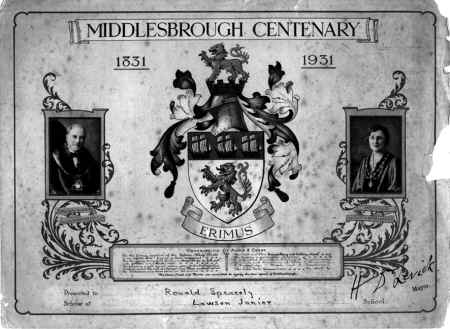|
George Spenceley recalls his childhood memories of Middlesbrough and how his large family coped with life in World War II and with the happy and sad events of family life.
The earliest memory I can have is from about the age of four. It was pre-war (WWII) days and I'd been given a small tin-plated toy as a present to mark the Coronation. It was a silver racing car and had a small Union Jack motif across the bonnet.
I can recall sitting on a grassy bank close to the Brambles Farm School and releasing the car then running to collect it. I remember wondering what a Coronation was.
Our house was number 7 Marshall Avenue, on the Brambles Farm Estate, a new area on the outskirts of Middlesbrough in Yorkshire, the largest county in the country. Middlesbrough only came into existence in 1830 when the land was purchased by a group of five Quakers.

Middlesbrough Coat of Arms
The above certificate was presented to my brother Ronnie to commemorate Middlesbrough's Centenary. The authority established a new port for the shipment of coal mined in the southern districts of County Durham.
There were vast amounts of coal in County Durham on the opposite side of the river Tees and that provided a constant supply of energy for the blast furnaces at the iron and steel works, to make pig iron. Mineral iron ore was also discovered in the nearby Cleveland hills.
The pig iron was made into ingots for the steel plants then processed into steel, reheated, rolled and pressed into steel girders to be used for bridge building or made into sheet metal of various thickness'. This was used in shipbuilding or very thin plate used for making metal cans etc.
Middlesbrough was famous for its steel and you can go to many parts of the world and see 'Made in Middlesbrough' stamped on bridge girders, the most famous being the Sydney Harbour Bridge in Australia.
Labour for the steel works came from many different areas of the country and from abroad. In the public houses you could hear many foreign dialects of the men who had moved into the district to earn a living. The downside to this influx of workers was the housing problem.
Back-to-back street houses were built with an alleyway running behind them where the coal man and refuse workers gained access.
The toilet was in the yard, at first just an earth closet or midden, it was emptied through a hole in the wall. Eventually these were updated to water toilets attached to the drains and refuse could be flushed away.
These often froze in cold winters causing the pipes to burst. Most folk had no indoor toilet or hot running water for a bath, only an old tin bath that was filled with hot water and used in front of the fire.
George Spenceley, 2002
| |


